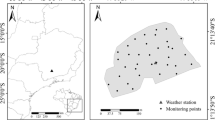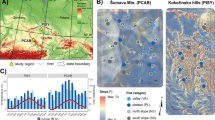Abstract
Many tree species have been shown to funnel substantial rainfall to their stem base as stemflow flux, given a favorable stand structure and storm conditions. As stemflow is a spatially concentrated flux, prior studies have shown its impact on ecohydrological and biogeochemical processes can be significant. Less work has been performed examining stemflow variability from meteorological conditions compared to canopy structural traits. As such, this study performs multiple regressions: (1) to examine stemflow variability due to event-based rainfall amount, intensity, mean wind speeds, and vapor pressure deficit; (2) across three diameter size classes (10–20, 21–40, and >41 cm DBH); and (3) for two common tree species in the northeastern USA of contrasting canopy morphology—Liriodendron tulipifera L. (yellow poplar) versus Fagus grandifolia Ehrh. (American beech). On the whole, multiple regression results yielded significant positive correlations with stemflow for rainfall amount, intensity, and mean wind speed and a significant negative correlation for vapor pressure deficit (VPD). Tree size altered stemflow-meteorological condition relationships, where larger trees strengthened indirect stemflow-VPD and direct stemflow-rainfall and stemflow-intensity associations. Canopies of rougher bark and lower branch angle (represented by L. tulipifera) enhanced correlations for nearly all meteorological conditions via greater stemflow residence time (and longer exposure to meteorological conditions). Multiple regressions performed on leafless canopy stemflow resulted in an inverse relationship with wind speeds, likely decoupling stemflow sheltered solely on bark surfaces from VPD influences. Leaf presence generally increased direct stemflow associations with rainfall intensity, yet diminished stemflow-rainfall relationships. F. grandifolia canopies (exemplifying structures of smoother bark and greater branch angle) strengthened differences in stemflow associations with rainfall/mean wind speed between leaf states. These findings are placed in a conceptual interception loss path analysis, which shows the potential to alter common interception loss estimates in high stemflow stands.




Similar content being viewed by others
References
Aboal JR, Morales D, Hernández M, Jiménez MS (1999) The measurement and modelling of the variation of stemflow in a laurel forest in Tenerife, Canary Islands. J Hydrol 221:161–175
André F, Jonard M, Ponette Q (2008) Influence of species and rain event characteristics on stemflow volume in a temperate mixed oak-beech stand. Hydrol Process 22:4455–4466
Brown JH, Barker AC (1970) An analysis of throughfall and stemflow in mixed oak stands. Water Resour Res 6:316–323
Carlyle-Moses DE, Gash JHC (2011) Rainfall interception loss by forest canopies. In: Levia DF, Carlyle-Moses DE, Tanaka T (eds) Forest hydrology and biogeochemistry: synthesis of past research and future directions (Ecological Studies Series 216). Springer, Heidelberg, pp 407–423
Carlyle-Moses DE, Price AG (2006) Growing-season stemflow production within a deciduous forest of southern Ontario. Hydrol Process 20:3651–3663
Chang SC, Matzner E (2000) The effect of beech stemflow on spatial patterns of soil solution chemistry and seepage fluxes in a mixed beech/oak stand. Hydrol Process 14:135–144
Clements JR (1972) Stemflow in a multi-storied aspen community. Can J For Res 2:160–165
Crockford RH, Richardson DP (2000) Partitioning of rainfall into throughfall, stemflow and interception: effect of forest type, ground cover and climate. Hydrol Process 14:2903–2920
Crozier CR, Boerner REJ (1984) Correlations of understory herb distribution patterns with microhabitats under different tree species in a mixed mesophytic forest. Oecologia 62:337–343
Devore J, Peck R (1993) Statistics, the exploration and analysis of data. Duxbury Press, Belmont, 881 p
Durocher MG (1990) Monitoring spatial variability of forest interception. Hydrol Process 4:215–229
Ford ED, Deans JD (1978) The effects of canopy structure on stemflow, throughfall and interception loss in a young Sitka spruce plantation. J Appl Ecol 15:905–917
Frost EE, Levia DF (2014) Hydrologic variation of stemflow yield across co-occurring dominant canopy trees of varying mortality. Ecohydrol In press
Gash JHC, Lloyd CR, Lachaud G (1995) Estimating sparse forest rainfall interception with an analytical model. J Hydrol 170:79–86
Germer S, Werther L, Elsenbeer H (2010) Have we underestimated stemflow? Lessons from an open tropical rainforest. J Hydrol 395:169–179
Guswa AJ (2012) Canopy vs. roots: production and destruction of variability in soil moisture and hydrologic fluxes. Vadose Zone J. doi:10.2136/vzj2011.0159
Guswa AJ, Spence CM (2012) Effect of throughfall variability on recharge: application to hemlock and deciduous forests in western Massachusetts. Ecohydrology 5:563–574
Hauck M, Hesse V, Runge M (2002) The significance of stemflow chemistry for epiphytic lichen diversity in a dieback-affected spruce forest on Mt Brocken, northern Germany. Lichenologist 34:415–427
Herwitz SR (1986) Infiltration-excess caused by stemflow in a cyclone-probe tropical rainforest. Earth Surf Process Landf 11:401–412
Herwitz SR, Slye RE (1995) Three-dimensional modeling of canopy tree interception of wind-driven rainfall. J Hydrol 168:205–226
Hutchinson I, Roberts MC (1981) Vertical variation in stemflow generation. J Appl Ecol 18:521–527
Inamdar SP, Mitchell MJ (2007) Storm event exports of dissolved organic nitrogen (DON) across multiple catchments in a glaciated forest watershed. J Geophys Res 112, G02014
Kuraji K, Yuri T, Nobuaki T, Isamu K (2001) Generation of stemflow volume and chemistry in a mature Japanese cypress forest. Hydrol Process 15:1967–1978
Levia DF, Frost EE (2003) A review and evaluation of stemflow literature in the hydrologic and biogeochemical cycles of forested and agricultural ecosystems. J Hydrol 274:1–29
Levia DF, Herwitz SR (2000) Physical properties of stemflow water in relation to leachate dynamics: implications for nutrient cycling. Can J For Res 30:662–666
Levia DF, Herwitz SR (2005) Interspecific variation of bark water storage capacity of three deciduous tree species in relation to stemflow yield and solute flux to forest soils. Catena 64:117–137
Levia DF, Van Stan JT, Mage SM, Kelley-Hauske PW (2010) Temporal variability of stemflow volume in a beech-yellow poplar forest in relation to tree species and size. J Hydrol 380:112–120
Levia DF, Keim RF, Carlyle-Moses DE, Frost EE (2011) Throughfall and stemflow in wooded ecosystems. In: Levia DF, Carlyle-Moses DE, Tanaka T (eds) Forest hydrology and biogeochemistry: synthesis of past research and future directions (Ecological Studies Series 216). Springer, Heidelberg, pp 425–443
Li X-Y, Yang Z-P, Li Y-T, Lin H (2009) Connecting ecohydrology and hydropedology in desert shrubs: stemflow as a source of preferential flow in soils. Hydrol Earth Syst Sci 13:1133–1144
Liang W, Kosugi K, Mizuyama T (2011) Soil water dynamics around a tree on a hillslope with or without rainwater supplied by stemflow. Water Resour Res 47, W02541
Liu S (1998) Estimation of rainfall storage capacity in the canopies of cypress wetlands and slash pine uplands in north-central Florida. J Hydrol 207:32–41
Llorens P, Domingo F (2007) Rainfall partitioning by vegetation under Mediterranean conditions. A review of studies in Europe. J Hydrol 335:37–54
Llorens P, Gallart F (2000) A simplified method for forest water storage capacity measurement. J Hydrol 240:131–144
Llorens P, Poch R, Latron J, Gallart F (1997) Rainfall interception by a Pinus sylvestris forest patch overgrown in a Mediterranean mountainous abandoned area I. monitoring design and results down to the event scale. J Hydrol 199:331–345
Maryland State Climatologist Office (2012) www.atmos.umd.edu/~climate [accessed June 2012]
Muzylo A, Llorens O, Domingo F (2012) Rainfall partitioning in a deciduous forest plot in leafed and leafless periods. Ecohydrology 5:759–767
Neave M, Abrahams AD (2002) Vegetation influences on water yields from grassland and shrubland ecosystems in the Chihuahuan Desert. Earth Surf Process Landf 27:1011–1020
Park H-T, Hattori S (2002) Applicability of stand structural characteristics on stemflow modelling. J For Res 7:91–98
Pypker TG, Levia DF, Staelens J, Van Stan JT (2011) Canopy structure in relation to hydrological and biogeochemical fluxes. In: Levia DF, Carlyle-Moses DE, Tanaka T (eds) Forest hydrology and biogeochemistry: synthesis of past research and future directions. Springer, Heidelberg, pp 371–388
Raat KJ, Draaijers GPJ, Schaap MG, Tietema A, Verstraten JM (2002) Spatial variability of throughfall water and chemistry and forest floor water content in a Douglas fir forest stand. Hydrol Earth Syst Sci 6:363–374
Rutter AJ, Kershaw KA, Robins PC, Morton AJ (1971) A predictive model of rainfall interception in forests, 1. Derivation of the model from observations in a plantation of Corsican pine. Agric Meteorol 9:367–384
Staelens J, de Schrijver A, Verheyen K, Verhoest NEC (2008) Rainfall partitioning into throughfall, stemflow, and interception within a single beech (Fagus sylvatica L.) canopy: influence of foliation, rain event characteristics, and meteorology. Hydrol Process 22:33–45
Valente F, David JS, Gash JHC (1997) Modelling interception loss for two sparse eucalypt and pine forests in central Portugal using reformulated Rutter and Gash analytical models. J Hydrol 190:141–162
Van Stan JT, Levia DF (2010) Inter- and intraspecific variation of stemflow production from Fagus grandifolia Ehrh. (American beech) and Liriodendron tulipifera L. (yellow poplar) in relation to bark microrelief in the eastern United States. Ecohydrology 3:11–19
Van Stan JT, Siegert CM, Levia DF, Scheick CE (2011) Effects of wind-driven rainfall on stemflow generation between codominant tree species with differing crown characteristics. Agric For Meteorol 151:1277–1286
Xiao Q, McPherson EG, Ustin SL, Grismer ME, Simpson JR (2000) Winter rainfall interception by two mature open grown trees in Davis, California. Hydrol Process 14:763–784
Acknowledgments
The authors gratefully acknowledge the staff and administration of the Fair Hill Natural Resource Management Area for having granted site access, providing surveillance, and incorporating our research results and infrastructure in their educational outreach activities. We also thank those who helped with site maintenance: Patrick Kelley-Hauske, Charles Apple, and John Fry.
Author information
Authors and Affiliations
Corresponding author
Rights and permissions
About this article
Cite this article
Van Stan, J.T., Van Stan, J.H. & Levia, D.F. Meteorological influences on stemflow generation across diameter size classes of two morphologically distinct deciduous species. Int J Biometeorol 58, 2059–2069 (2014). https://doi.org/10.1007/s00484-014-0807-7
Received:
Revised:
Accepted:
Published:
Issue Date:
DOI: https://doi.org/10.1007/s00484-014-0807-7




